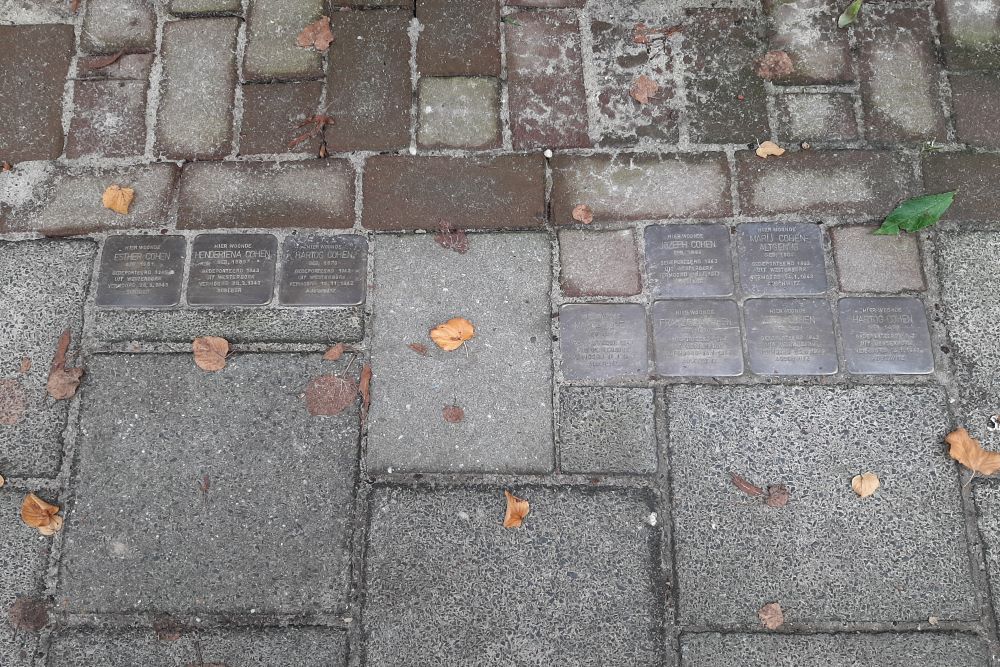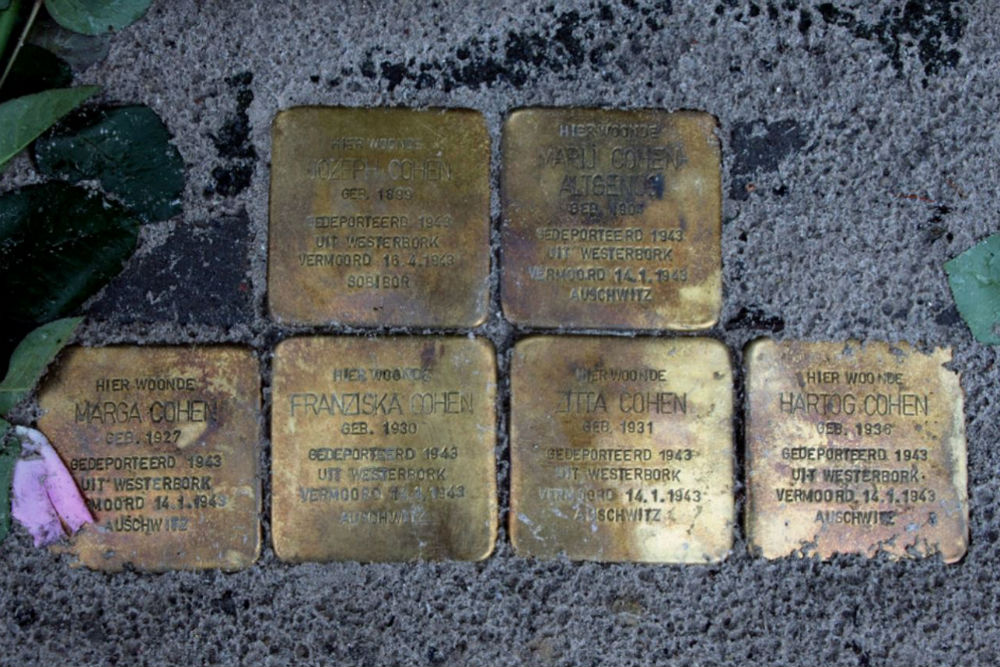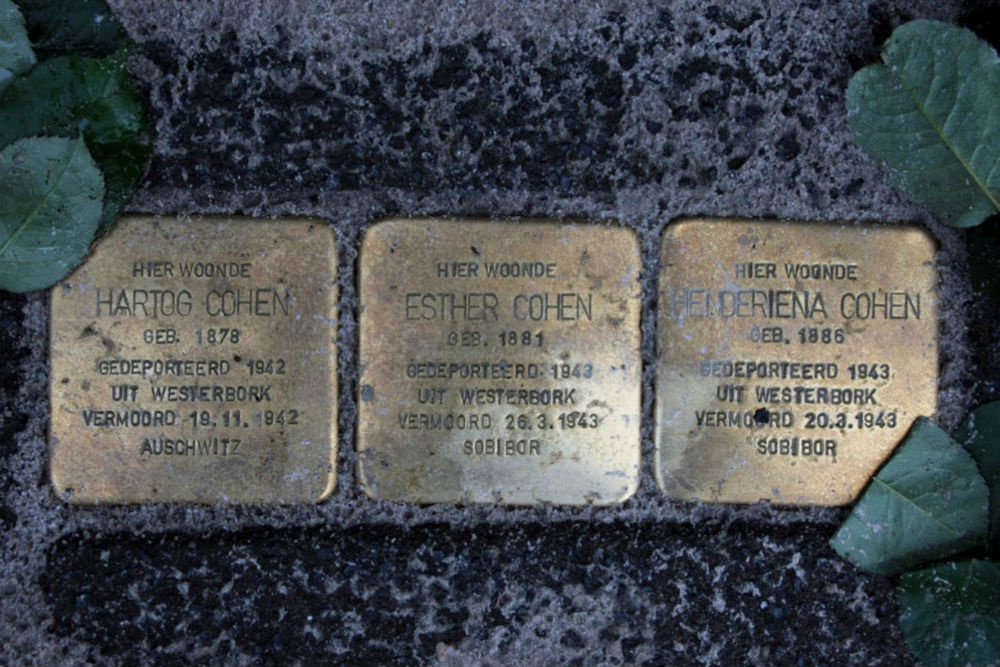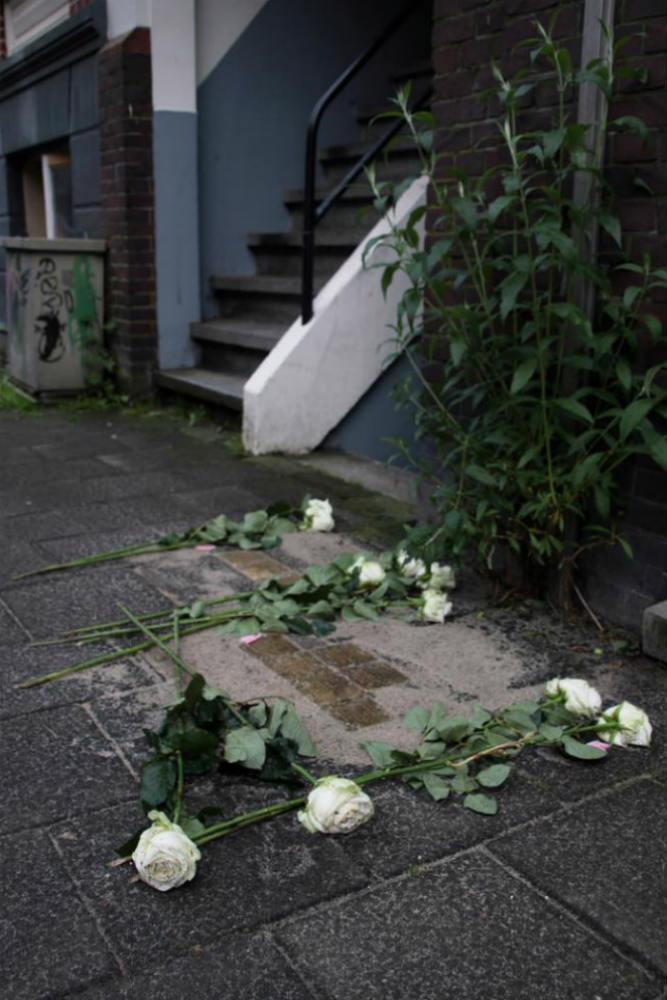Stumbling Stones Jozef Israėlsstraat 18a
Here lived:
Jozeph Cohen
Born: 27-08-1899 in Oude Pekela
Deported to Westerbork: 08-04-1943
Killed: 16-04-1943 in Sobibor
Marij Cohen-Altgenug
Born: 05-06-1904 in Norden, Germany
Deported to Westerbork: 24-12-1942
Killed: January 14, 1943 in Auschwitz
Marga Cohen
Born: 15-02-1927 in Esens, Germany
Deported to Westerbork: 24-12-1942
Killed: January 14, 1943 in Auschwitz
Franziska Cohen
Born: 03-05-1930 in Esens, Germany
Deported to Westerbork: 24-12-1942
Killed: January 14, 1943 in Auschwitz
Zitta Cohen
Born: 26-09-1931 in Esens, Germany
Deported to Westerbork: 24-12-1942
Killed: January 14, 1943 in Auschwitz
Hartog Cohen
Born: 09-11-1936 in Esens Germany
Deported to Westerbork: 24-12-1942
Killed: January 14, 1943 in Auschwitz
Hartog Cohen
Born: 25-06-1878 in Ihrhove, Germany
Deported to Westerbork: 12-11-1942
Killed: 19-11-1942 in Auschwitz
Esther Cohen
Born: 11-01-1881 in Ihrhove, Germany
Deported to Westerbork: 11-03-1943
Killed: 26-03-1943 in Sobibor
Henderiena Cohen
Born: 19-09-1886 in Loga, Germany
Deported to Westerbork: 09-03-1943
Killed: 20-03-1943 in Sobibor
Jozef Cohen, a cattle salesman, and Marij Altgenug married in 1924. Daughter Helga was born first (she survived the war), then Marga, Franziska, Zitta, and a boy, Hartog. They lived in Esens, Germany. In 1933, Jozef was subjected to the "Berufsverbot" the ban of Jews in specified occupations. The family went to the Netherlands, then returned to Esens after a year. Jozef registered his family in Groningen, at this address, in the autumn of 1937. No longer in the cattle business, Jozef is described as trading in potatoes.
On 24 December 1942, Marij and their four younger children were taken to Westerbork (less than 50 km from Groningen), and a few weeks later were deported from there on 11 January 1943 to Auschwitz, where they were killed the day after their arrival. Of the 851 deportees on that Westerbork-Auschwitz train, only 8 survived the war.
Jozefs mother, Hanni Cohen née Wienthal, lived with them until July 1942, when she moved to Beth Zekenim, the Jewish home for the elderly at Schoolholm 26 in Groningen. She was murdered in Auschwitz on 14 January 1943, the same day as her 4 grandchildren and her daughter-in-law, Marij.
Jozef himself lived a little longer. He was the last person to be taken from the apartment: he was taken to Westerbork on 08 April 1943. Then, with 1,203 other men, women, and children, he was deported from Westerbork on 13 April 1943 and murdered three days later in Sobibor. He was 43.
Three other Cohens, born in the 1800s, were impoverished siblings, who lived at this address, but their relationship to Jozef Cohens family is not known. They had come to this address in 1939.
Hartog Cohen, an unmarried cattle dealer, was taken to Westerbork 12 November 1942, then deported on 16 November 1942 to Auschwitz, one or two days later. He was murdered there shortly after arrival. He was 64. Only three persons from this transport of 763 men, women, and children are known to have survived the war.
Henderiena Cohen was deaf, and often bedridden. She was taken to Westerbork on 9 March 1943, then deported on 17 March with 963 others to Sobibor. She, age 56, was murdered on arrival there 3 days later. Only one person on that transport survived.
Finally, Esther Cohen was taken to Westerbork on 11 March 1943 and then deported on 23 March to Sobibor, where she was murdered on arrival. She was 62. None of the 1250 men, women and children on that transport survived the war.
"Stolpersteine" is an art project for Europe by Gunter Demnig to commemorate victims of National Socialism (Nazism). Stolpersteine (stumbling stones) are small, 10x10cm brass plaques placed in the pavement in front of the last voluntary residence of (mostly Jewish) victims who were murdered by the Nazis. Each plaque is engraved with the victims name, date of birth, and place (mostly a concentration camp) and date of death. By doing this, Gunter Demnig gives an individual memorial to each victim. One stone, one name, one person. He cites the Talmud: "A human being is forgotten only when his or her name is forgotten."
Do you have more information about this location? Inform us!
Source
- Text: Bert Deelman & Anne Palmer
- Photos: Bert Deelman (1, 5), Suzanne Matrosov-Vruggink (2), Suzanne Matrosov-Vruggink (3), Suzanne Matrosov-Vruggink (4)
- Biografie Familie Cohen
- Yad Vashem: Deportation Westerbork-Auschwitz, 11 January 1943
- Joods Monument
- Yad Vashem Central Database of Shoah Victims Names
- Stolpersteine.eu
Nearby
Point of interest
- Remenbrance place Blekerstraat 24a - Groningen
- Remembrance place H.W. Mesdagstraat 3 - Groningen
- Headquarters 1st SS-Standard Germanic-SS - Groningen
Monument
- War Monument Schilderswijk - Groningen
- Memorial Post Office Groningen - Groningen
- Memorial Academy Building University - Groningen
Cemetery
- Commonwealth War Graves Groningen - Groningen
- Dutch War Graves Northern Cemetery - Groningen
- Dutch War Graves Zuiderbegraafplaats - Groningen
Remembrance Stone
- Stumbling Stones Jozef Israëlsstraat 16 - Groningen
- Stumbling Stone Jozef Israëlsstraat 16a - Groningen
- Stumbling Stones Jozef Israëlsstraat 22a - Groningen
Fortification
- German Shelter Suikerunie Factory - Groningen
- German Tobruk Bunker Suikerunie Factory - Groningen
- German Bunker Haren - Haren








